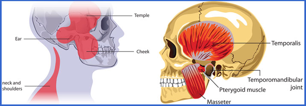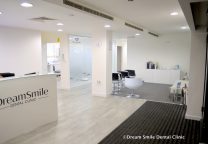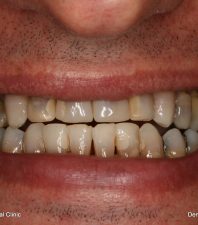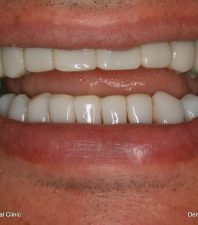Tooth Grinding
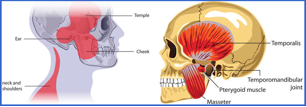
Bruxism or tooth grinding and clenching is a common problem that afflicts many of us at different stages throughout our lives. Bruxism is often stress related. Under certain circumstances alteration to the occlusion of the teeth (i.e. after a filling is placed) or after a traumatic injury to the temporomandibular joint (jaw joint or TMJ) can cause bruxism and lead to the classic signs and symptoms of this condition. In some cases the pain associated with Bruxism can be confused with wisdom tooth pain. Although tooth grinding /clenching can occur during waking hours, this usually occurs whilst sleeping.
Signs and Symptoms
Back to topThe main signs and symptoms of a bruxism problem are:
- Biting surfaces of the teeth become flat and worn
- The biting surfaces become sensitive to cold fluids and sugars
- Tension and tenderness in the muscles surrounding the jaw and in the TMJ
- Waking in the morning with headaches, and occasionally associated neck or jaw pain
- Disturbed sleep patterns
Why use it?
Back to topWhat to do?
If you are suffering from any of these symptoms, or have noticed your teeth becoming worn, there are different treatment methods that can be adopted depending on the severity of the case. Once a patient has been diagnosed as suffering from a bruxism problem the first step is for the patient to become aware of it.
Step One – Awareness
- Become aware of the problem
- Attempt to decrease stresses in life
- Begin a soft food diet
- Cut food up into small pieces
- Loosen jaw muscles with exercise
- Ensure teeth are not touching when falling asleep and when waking up
- Heat pads on the jaw muscles
Step Two – Appliance intervention
- If the tooth wear persists, however no muscle or joint pain is experienced, a soft night guard can be constructed to protect the teeth during the night.
- If muscle and joint pain persists with or without tooth wear a ‘hard’ night guard or splint should be constructed. This acts as a ‘crutch’, stretching the muscles and preventing them from bruxing the teeth.
Step Three
If pain persists a combination of analgesics and muscle relaxants maybe required.
Step Four
Where the above treatment fails, investigations into the TMJ it self may be carried out. Occasionally degenerative joints are found to be the underlying cause of the symptoms requiring correctional surgery, orthodontics and/or Full Mouth Bite Rehabilitation. This fortunately is very rare.
Other Concerns
Use of a splint is recommended for all people who suffer bruxism as well as patients with restorations requiring protection ie. Crowns, Veneers, Implants and fillings.
Factors that increase the risk of Bruxism (and erosion)
There are several factors which increase the risk of future wear and damage from bruxism.
- Medications – including antideppressants and stimulants. Certain types are known to trigger bruxism as well as reducing saliva causing a dry mouth.
- Dry Mouth – Lack of lubrication from saliva increases the potential for tooth wear. This can be a result of dehydration, excessive alcohol, caffeine and certain medications.
- Acidity in the Mouth – This can occur from a high intake of fruit juice, wine, cola, soft drinks, sport drinks or stomach reflux.
- Stress and Anxiety – This can lead to increased levels of bruxism and reduced saliva.
- Exposed Dentine – This is softer than enamel and wears at a quicker rate.
Fortunately Bruxism can be controlled in most cases. As stated bruxism is often stress related. I often say to my patients, “Before we begin any treatment for bruxism how about taking a holiday?”
The temporomandibular joints (TMJ) connect the lower jaw, or mandible, to the temporal bones at the sides of the head. These joints are flexible and allow the jaw to move smoothly up and down and side to side enabling us to talk, chew and yawn. TMJ dysfunction (tooth grinding) involves facial pain, clicking sounds in the TMJ and restricted movement of the jaw. It is otherwise known as tooth grinding.
The treatment process
Back to topTMJ disorders are best treated cautiously, using treatment methods that do not have any permanent effect on the teeth and jaw joint. Commonly TMJ disorders are of a temporary nature and simple treatments are used to help reduce symptoms and restore jaw function. A tooth grinding treatment plan will be developed and specifically customised for your needs. For the best results it is important to follow your treatment plan.
The treatment plan may include some of the following treatments:
- Occlusal appliance therapy – may be used to take pressure off the jaw joints and teeth.
- Modified diet – to minimise chewing and rest the jaw.
- Avoid extreme jaw movement – ie. Yawning, chewing etc.
- Physiotherapy – exercises, massage, gentle movement etc.
- Warm or cold packs – by applying cold or warm packs, muscle relaxation can be achieved
- Relaxation and stress management – learn how to relax and lessen stress.
- Medication – in some cases short term medication may be recommended.
Tooth Grinding Treatment Time
In some cases the treatment may take up to several months to be effective.

